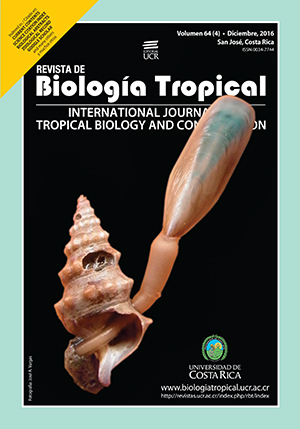Abstract
The light environment in the understory of cloud forests is highly heterogeneous and determined by species composition, canopy structure, site conditions, and seasonality. This study was carried out at San Eusebio cloud forest, Venezuela (2 300 - 2 500 masl). The impact of canopy structure variations on understory light availability was estimated in the dry (December-February) and rainy (March-November) seasons, in sites under continuous canopy cover and gaps of various sizes. Hemispherical photographs were taken to estimate the percentage of canopy openness, leaf area index, percentages of transmitted direct and diffuse light, and duration and frequency of sunflecks. A light index was calculated from the relative proportions of direct and diffuse light transmitted to the understory. For most variables, there were significant differences between seasons, as well as among different gap sizes and under closed canopy. The light index was low (0.25 to 26 of a maximum = 100), even for the largest gaps, indicating a highly shaded light environment, especially beneath closed canopy in the rainy season. Patterns and interactions among factors were analyzed (gaps vs. continuous canopy, gap sizes, location within the gaps, and seasonality) with a mixed effects repeated measures Anova design. Results showed that the amount of light reaching the understory is low in both gaps and closed canopy. However, small but significant differences in light availability existed for both seasonality and magnitude of the perturbations. These differences could contribute to explain the dynamics of tree species regeneration in this forest. The knowledge of the factors conditioning light availability in the understory where tree regeneration begins is crucial in cloud forests because of energetic limitations in this ecosystem, and might be essential for future restoration and conservation plans concerning the preservation of the diversity and integrity of these forests.
References
Acevedo, M., Ataroff, M., Monteleone, S., & Estrada, C. (2003). Heterogeneidad estructural y lumínica del sotobosque de una selva nublada andina de Venezuela. Interciencia, 28, 394-403.
Asner, G. P., Scurlock, J. O., & Hicke, J. A. (2003). Global synthesis of leaf area index observations: implications for ecological and remote sensing studies. Global Ecology & Biogeography, 12, 191-205.
Brokaw, N. (1985). Gap-Phase Regeneration in a Tropical Forest. Ecology, 66, 682-687.
Canham, C. D. (1988). An index for understory light levels in and around canopy gaps. Ecology, 69, 1634-1638.
Cescatti, A., & Niinemets, U. (2004). Leaf to Landscape. In W. K. Smith, T. C. Vogelmann & C. Chritchley (Eds.), Photosynthetic Adaptation: Chloroplast to Landscape (pp. 42-84). New York, USA: Springer.
Endler, J. A. (1993). The Color of Light in Forests and Its Implications. Ecological Monographs, 63, 1-27.
Figueroa, J. A., & Lusk, C. H. (2001). Germination requirements and seedling shade tolerance are not correlated in a Chilean temperate rain forest. New Phytologist, 152, 483-489.
Frazer, G. W., Canham, C. D., & Lertzman, K. P. (1999). Gap Light Analyzer (GLA), Version 2.0: Imaging software to extract canopy structure and gap light transmission indices from true-color fisheye photographs. New York, USA: Simon Fraser University, Burnaby, BC, and the Institute of Ecosystem Studies, Millbrook. Available in http://www.rem.sfu.ca/forestry/ index.htm or http://www.ecostudies.org
García, C., Azócar, A., & Rada, F. (1995). Photosynthetic acclimation to light in juveniles of two cloud forest tree species. Tree, 10, 114-124.
Hogan, K. P., & Machado, J. L. (2002). La luz solar: consecuencias biológicas y su medición. In M. R. Guariguata & G. H. Kattan (Eds.), Ecología y Conservación de Bosques Neotropicales (pp. 119-143). Cartago, Costa Rica: LUR.
Luna, I., Velázquez, A., & Velázquez, E. (2001). México. In M. Kapelle & A. D. Brown (Eds.), Bosques Nublados del Neotrópico (pp. 183-229). Costa Rica: INBio.
Lusk, C. H., Chazdon, R., & Hofmann, G. (2006). A bounded null model explains juvenile tree community structure along light availability gradients in a temperate rain forest. Oikos, 112, 131-137.
Márquez, O. (1990). Génesis de una secuencia de suelos en el Bosque Experimental San Eusebio, La Carbonera. Estado Mérida. Revista Forestal Venezolana, 32, 133-150.
Meir, P., Grace, J., & Miranda, A. (2000). Photographic method to measure the vertical distribution of leaf area density in forests. Agricultural and Forest Meteorology, 102, 111-105.
Montgomery, R. A., & Chazdon, R. L. (2002). Light gradient partitioning by tropical tree seedlings in the absence of canopy gaps. Oecologia, 131, 165-174.
Negrón, R., Ribeiro, H., Silva, A., Goulden, M. L., & Miller, S. (2009). An improved estimate of leaf area index based on the histogram analysis of hemispherical photographs. Agricultural and Forest Meteorology, 149, 920-928.
Nobis, M., & Hunziker, U. (2005). Automatic thresholding for hemispherical canopy-photographs based on edge detection. Agricultural and Forest Meteorology, 128, 243-250.
Ostertarg, R. (1998). Belowground effects of canopy gaps in a tropical wet forest. Ecology, 79, 1294-1304.
Pearcy, R. W. (2007). Responses of Plants to Heterogeneous Light Environments. In F. Pugnaire, & F. Valladares (Eds.), Functional Plant Ecology (pp. 213-255). New York, USA: Marcel Dekker Inc.
Poorter, L., & Arets, E. J. (2003). Light environment and tree strategies in a Bolivian tropical moist forest: an evaluation of the light partitioning hypothesis. Plant Ecology, 166, 295-306.
Ramos, M. C., & Plonczak, M. A. (2007). Dinámica sucesional del componente arbóreo luego de un estudio destructivo de biomasa en el Bosque Universitario San Eusebio, Mérida Venezuela. Revista Forestal Venezolana, 51, 35-46.
SAS. (2004). SAS/STAT 9.1. SAS, NC. USA: Institute Inc.Cary.
Schwarzkopf, T., Riha, S. J., Fahey, T. J., & DeGloria, S. (2011). Are could forest tree structure and environment related in the Venezuela Andes? Austral Ecology, 36, 280-289.
Turnbull, M. H., & Yates, D. J. (1993). Seasonal Variation in the Red/Far-Red Ratio and Photon Flux Density in an Australian Sub-Tropical Rainforest. Agricultural and Forest Meteorology, 64, 111-127.
Zhang, Y. C., Jing, M., & Miller, J. R. (2005). Determining digital hemispherical photograph exposure for leaf area index estimation. Agricultural and Forest Meteorology, 133, 166-181.
##plugins.facebook.comentarios##

This work is licensed under a Creative Commons Attribution 4.0 International License.
Copyright (c) 2016 Revista de Biología Tropical






